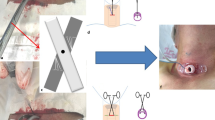Abstract
Purpose
Percutaneous dilatational tracheostomy (PDT) is a standard procedure routinely performed on intensive care units. While complication rates and long-term outcomes have been studied in different patient populations, there are few studies known to these authors involving PDT in trauma patients and the complications which may result.
Methods
Between March 2007 and August 2013, all instances and peri-procedural complications during PDT occurring on the trauma intensive care unit, a unit specialized in the care of injured patients and especially polytrauma patients, were documented. PDTs were performed by a surgeon with the assistance and supervision of another, using bronchoscopic guidance performed by the respiratory medicine department.
Results
289 patients were included in the study, 225 men and 64 women with a mean age of 49 ± 21 years. Complications occurred in 37.4 % of cases. The most common complication, bleeding, occurred in 26.3 % of patients ranging from little to severe bleeding. Fracture of tracheal cartilage occurred in 6 % of PDT cases. Additional complications such as dislocation of the guidewire, hypotension, and oxygen desaturation were observed. Most complications did not require treatment. The second tracheal intercartilaginous space was successfully intubated in 82 % of cases.
Conclusions
PDT is a safe procedure in trauma patients. When considering the severity of complications such as major blood loss, pneumothorax, or death, this evidence suggests that PDT is safer in trauma patients compared to other patient cohorts.



Similar content being viewed by others
References
Yavuz A, Yilmaz M, Goya C, Alimoglu E, Kabaalioglu A. Advantages of US in percutaneous dilatational tracheostomy: randomized controlled trial and review of the literature. Radiology. 2014;273:927–36.
Cheung NH, Napolitano LM. Tracheostomy: epidemiology, indications, timing, technique, and outcomes. Respir Care. 2014;59:895–915 (discussion 916-9).
Gobatto AL, Besen BA, Tierno PF, et al. Comparison between ultrasound- and bronchoscopy-guided percutaneous dilational tracheostomy in critically ill patients: a retrospective cohort study. J Crit Care. 2015;30:220.e13–7.
Siempos II, Ntaidou TK, Filippidis FT, Choi AM. Effect of early versus late or no tracheostomy on mortality and pneumonia of critically ill patients receiving mechanical ventilation: a systematic review and meta-analysis. Lancet Respir Med. 2015;3:150–8.
Meininger D, Walcher F, Byhahn C. Tracheostomy in intensive care long-term ventilation : indications, techniques and complications. Chirurg. 2011;82(107–10):112–5.
Shapiro M, Wilson RK, Casar G, Bloom K, Teague RB. Work of breathing through different sized endotracheal tubes. Crit Care Med. 1986;14:1028–31.
Bishop MJ, Hibbard AJ, Fink BR, Vogel AM, Weymuller EA Jr. Laryngeal injury in a dog model of prolonged endotracheal intubation. Anesthesiology. 1985;62:770–3.
Weymuller EA Jr, Bishop MJ, Fink BR, Hibbard AW, Spelman FA. Quantification of intralaryngeal pressure exerted by endotracheal tubes. Ann Otol Rhinol Laryngol. 1983;92:444–7.
Das P, Zhu H, Shah RK, Roberson DW, Berry J, Skinner ML. Tracheotomy-related catastrophic events: results of a national survey. Laryngoscope. 2012;122:30–7.
Bederman SS, Murnaghan O, Malempati H, et al. In-hospital mortality and surgical utilization in severely polytraumatized patients with and without spinal injury. J Trauma. 2011;71:E71–8.
Gothner M, Buchwald D, Schlebes A, Strauch JT, Schildhauer TA, Swol J. Use of extracorporeal membrane oxygenation in combination with high-frequency oscillatory ventilation in post-traumatic ARDS. Acta Anaesthesiol Scand. 2013;57:391–4.
Ai XS, Gou DY, Zhang L, Chen LY. Percutaneous dilatational tracheostomy for ICU patients with severe brain injury. Chin J Traumatol. 2014;17:335–7.
Al-Ansari MA, Hijazi MH. Clinical review: percutaneous dilatational tracheostomy. Crit Care. 2006;10:202.
Jacobs JV, Hill DA, Petersen SR, Bremner RM, Sue RD, Smith MA. “Corkscrew stenosis”: defining and preventing a complication of percutaneous dilatational tracheostomy. J Thorac Cardiovasc Surg. 2013;145:716–20.
Keller MW, Han PP, Galarneau MR, Brigger MT. Airway management in severe combat maxillofacial Trauma. Otolaryngol Head Neck Surg. 2015. doi:10.1177/0194599815576916.
Ciaglia P, Firsching R, Syniec C. Elective percutaneous dilatational tracheostomy. A new simple bedside procedure; preliminary report. Chest. 1985;87:715–9.
Hameed AA, Mohamed H, Al-Ansari M. Experience with 224 percutaneous dilatational tracheostomies at an adult intensive care unit in Bahrain: a descriptive study. Ann Thorac Med. 2008;3:18–22.
Oggiano M, Ewig S, Hecker E. A comparison of percutaneous dilatational tracheostomy versus conventional surgical tracheostomy. Pneumologie. 2014;68:322–8.
Yaghoobi S, Kayalha H, Ghafouri R, Yazdi Z, Khezri MB. Comparison of complications in percutaneous dilatational tracheostomy versus surgical tracheostomy. Glob J Health Sci. 2014;6:221–5.
Simon M, Metschke M, Braune SA, Puschel K, Kluge S. Death after percutaneous dilatational tracheostomy: a systematic review and analysis of risk factors. Crit Care. 2013;17:R258.
Massick DD, Yao S, Powell DM, et al. Bedside tracheostomy in the intensive care unit: a prospective randomized trial comparing open surgical tracheostomy with endoscopically guided percutaneous dilational tracheotomy. Laryngoscope. 2001;111:494–500.
Takahashi M, Itagaki S, Laskaris J, Filsoufi F, Reddy RC. Percutaneous tracheostomy can be safely performed in patients with uncorrected coagulopathy after cardiothoracic surgery. Innovations (Phila). 2014;9:22–6.
Barton CA, McMillian WD, Osler T, et al. Anticoagulation management around percutaneous bedside procedures: is adjustment required? J Trauma Acute Care Surg. 2012;72:815–20 (quiz 1124-5).
Andriolo BN, Andriolo RB, Saconato H, Atallah AN, Valente O. Early versus late tracheostomy for critically ill patients. Cochrane Database Syst Rev. 2015;1:CD007271.
Author information
Authors and Affiliations
Corresponding author
Ethics declarations
Conflict of interest
Sebastian Decker, Jens Gottlieb, Dana Leslie Cruz, Christian Walter Müller, Mathias Wilhelmi, Christian Krettek, and Michaela Wilhelmi declare that they have no conflict of interest.
Ethical approval
All procedures performed in studies involving human participants were in accordance with the ethical standards of the institutional and/or national research committee and with the 1964 Helsinki declaration and its later amendments or comparable ethical standards. For this type of study, formal consent is not required.
Rights and permissions
About this article
Cite this article
Decker, S., Gottlieb, J., Cruz, D.L. et al. Percutaneous dilatational tracheostomy (PDT) in trauma patients: a safe procedure. Eur J Trauma Emerg Surg 42, 605–610 (2016). https://doi.org/10.1007/s00068-015-0578-9
Received:
Accepted:
Published:
Issue Date:
DOI: https://doi.org/10.1007/s00068-015-0578-9



